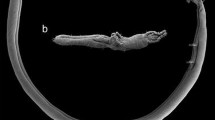Summary
Cinefilms of unconstrained P. vulgaris at 17°C were taken at a low magnification (∼2x) and 120–200 fps to analyze body movements during swimming and escape responses mediated by movements of the 12 lateral, bladelike appendages or paddles. Cinefilms of partially constrained P. vulgaris and P. dolichoptera at 16°C were taken at a higher magnification (∼10x) and 300 fps, using interference contrast optics, to resolve paddle movements during escape responses. When swimming, P. vulgaris moved at a velocity of 0.348±0,025 (S.E.) mm·s-1 (2.64 body lenghs·s-1), having a Reynolds number of 0.05. During escape responses, P. vulgaris traveled 1.947±0.124 (S.E.) mm (15 body lengths) during 0.0564±0.0038 (S.E.) s, continuously moving at a velocity of 35.7±1.2 (S.E.) mm·s-1 (270 body lengths·s-1) and having a Reynolds number of 5. During these responses, P. vulgaris tumbled sinuously but mostly-88.9±2.3 (S.E.) %-in a constant direction; the angular change in direction from one frame to the next was 28±2 (S.E.) degrees, but the sign of the change in direction frequently alternated. Escape responses are caused by 1–3 cycles of paddle movements. In each cycle, the rigid paddles move up asynchronously until they are all directly overhead, and then they move downwards to their original resting positions, again asynchronously. Polyarthra's body moves along the flight path during all phases of this cycle. A single cycle may take as little as 26 ms, 13 ms for the paddles to elevate and 13 ms for them to descend. The asynchronous upward and downward movements of each of the 12 paddles explain why Polyarthra's body tumbles continuously through its low Reynolds number, viscous environment. Escape responses generally were initiated by contact with another rotifer. In one P. dolichoptera response, the time lag between such contact and the initiation of paddle elevation was about 7 ms. The very short lag time, great velocity, considerable displacement, and unpredictable directionality of Polyarthra's escape response make it a very effective defense against capture by some invertebrate predators.
Similar content being viewed by others
References
Allen AA (1968) Morphology of the planktonic rotifer Polyarthra vulgaris. Trans Amer Micr Soc 87:60–69
Brandl Z, Fernando CH (1978) Prey selection by the cyclopoid copepods Mesocyclops edax and Cyclops vicinus. Verh Internat Verein Limnol 20:2505–2510
Crecco VA, Blake MM (1983) Feeding ecology of coexisting larvae of American shad and blueback herring in the Connecticut River. Trans Amer Fish Soc 112:498–507
Ejsmont-Karabin J (1974) Studies on the feeding of planktonic polyphage Asplanchna priodonta Gosse (Rotatoria). Ekol Pol 22:311–317
Epp RW, Lewis WM Jr (1984) Cost and speed of locomotion for rotifers. Oecologia (Berlin) 61:289–292
Gilbert JJ (1980) Feeding in the rotifer Asplanchna: behavior, cannibalism, selectivity, prey defenses, and impact on rotifer communities. In: Kerfoot WC (ed) Evolution and ecology of zooplankton communities. University Press of New England, pp 158–172
Gilbert JJ, Stemberger RS (1985a) The costs and benefits of gigantism in polymorphic species of the rotifer Asplanchna. Arch Hydrobiol Beih (in press)
Gilbert JJ, Stemberger RS (1985b) Prey capture in the rotifer Asplanchna girodi. Verh Internat Vercin Limnol 22 (in press)
Gilbert JJ, Williamson CE (1978) Predator-prey behavior and its effect on rotifer surival in associations of Mesocyclops edax, Asplanchna girodi, Polyarthra vulgaris, and Keratella cochlearis. Oecologia (Berlin) 37:13–22
guiset A (1977) Stomach contents in Asplanchna and Ploesoma. Arch Hydrobiol Beih 8:126–129
Magnien RE (1983) Analysis of zooplankton dynamics: case studies of temporal succession controlled by the predator, Asplanchna, and of diel cycles in Keratella. PhD Thesis. Dartmouth College, p 187
Salt GW, Sabbadini GF, Commins ML (1978) Trophi morphology relative to food habits in six species of rotifers (Asplanchnidae). Trans Amer Micr Soc 97:469–485
Siefert RE (1972) First food of larval yellow perch, white sucker, bluegill, emerald shiner, and rainbow smelt. Trans Amer Fish Soc 101:219–225
Sleigh MA, Blake JR (1977) Methods of ciliary propulsion and their size limitations. In: Pedley JR (ed) Scale effects in animal locomotion. Academic Press, pp 243–256
Stemberger RS (1985) Prey selection by the copepod Diacyclops thomasi. Oecologia (Berlin) (in press)
Stemberger RS, Gilbert JJ (1985) Body size, food concentration, and population growth in planktonic rotifers. Ecology (in press)
Williamson CE (1983) Invertebrate predation on planktonic rotifers. Hydrobiologia 104:385–396
Author information
Authors and Affiliations
Rights and permissions
About this article
Cite this article
Gilbert, J.J. Escape response of the rotifer Polyarthra: a high-speed cinematographic analysis. Oecologia 66, 322–331 (1985). https://doi.org/10.1007/BF00378293
Received:
Issue Date:
DOI: https://doi.org/10.1007/BF00378293




